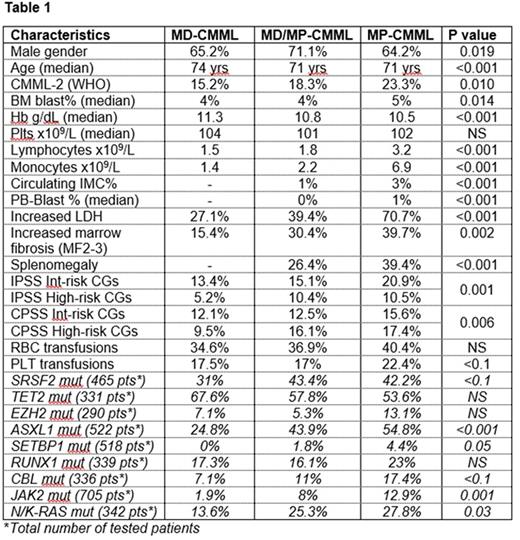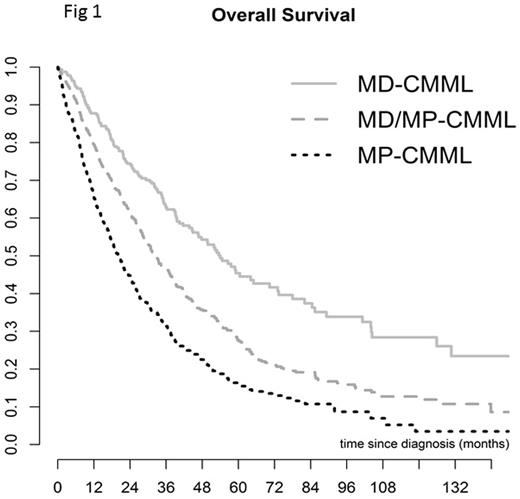Abstract

Introduction: CMML is a clinically heterogeneous myeloid neoplasm hallmarked by the coexistence of dysplastic and proliferative patho-clinical features, which can include cytopenias, constitutional symptoms, splenomegaly, and leukocytosis. However, according to the FAB classification schema, CMML may be differentiated in dysplastic and proliferative subgroups only by the presence of leukocytosis in the latter (WBC ≥13 x 109/L). We hypothesize that incorporation of other clinically discriminating features may yield a more informative CMML stratification system. To address this, we propose three distinct CMML categories and explore their clinical relevance leveraging our existing international CMML database (Padron E et al. Blood Cancer J. 20151).
Method: 1622 WHO-defined CMML cases diagnosed between 1973 and 2014 were collected from eight large cancer centres that include up to 80 discrete data elements as previously described1. Cases were placed into three clinically distinct groups and the Pearson Chi-Square test and the Kruskal-Wallis test were applied respectively to compare categorical and continuous characteristics. The Kaplan-Meier (KM) method was used to estimate median OS and the log rank test was used to compare survival curves.Cox models whereapplied to obtain univariate and adjusted hazard ratios. Identification of optimal cut-off values for continuous variable was supported by graphical inspection of martingale residuals from the null Cox model. Statistical analyses were done in SPSS v23 and R v.3.3.0.
Results: We propose three categories to delineate clinically distinct CMML subtypes: (1) Myelodysplastic (MD)-CMML: WBC≤10 x 109/L, PB-immature myeloid cells (IMC) = 0%, no splenomegaly (2) MD/MP-CMML: WBC 10-20 x 109/L or WBC ≤10 x 109/L but PB-IMC>0% and/or splenomegaly (3) Myeloproliferative (MP)-CMML: WBC >20 x 109/L. A recursive partitioning approach was used to identify the WBC cut points, with splenomegaly and IMC added to more accurately depict the MPN aspect of CMML. Numbers of patients included in the MD-, MD/MP-, and MP-CMML subcategories were 319 (19.7%), 789 (48.6%) and 514 (31.7%), respectively (Table 1). According to the FAB criteria, the MD/MP group included 521 (66%) MD- (WBC ≤13 x 109/L) and 268 (34%) MP-CMML (WBC>13 x 109/L) patients suggesting that the proposed classification clinically reclassifies FAB-defined CMML. Within the MD/MP group, 344 patients (21.2%) had a WBC <10 x 109/L but with IMC>0% and/or splenomegaly. Comparison of overall survival (OS) among proposed groups demonstrated that this classification schema was capable of discriminating the CMML natural history (Figure 1). In comparison to MD/MP-CMML, the unadjusted OS Hazard Ratio (HR) was 0.60 (95% CI 0.49-0.73) for MD-CMML and 1.57 (95% CI 1.36-1.81) for MP-CMML (p<0.001 for both). This difference was retained after adjusting for BM-Blasts (< vs ≥5%), IPSS or CPSS cytogenetics (High-risk vsInterm/low-risk), and elevated levels of LDH (HR was 0.73 with 95% CI 0.57-0.93, p=0.011 for MD-CMML, and 1.33 with 95% CI 1.12-1.58, p=0.001 for MP-CMML, respectively).
We next explored whether each proposed group may have distinct variables that uniquely govern its prognosis. Peripheral blood blasts >5%, RBC- and PLT-transfusion-dependence predicted poor OS only in the MD and MD/MP-subcategories (p<0.005), but had no impact in the MP-CMML. Male gender and elevated LDH were only significantly associated with prognosis in the MD/MP group (p<0.05 and p<0.005, respectively) while absolute lymphocyte count >2.5 x 109/L and absolute monocyte count >10 x109/L were uniquely predictive for shorter survival in the MP-CMML subcategory (p<0.005). Notably, we additionally identified gene mutations that uniquely predicted prognosis in each proposed group (Table 2).
Conclusions: We demonstrate that our proposed 3-group clinical classification schema is capable of independently stratifying prognosis. Further, our analysis identified clinical and genetic variables that uniquely govern each group's prognosis, suggesting independent clinical behaviour. Further investigations are warranted to validate these groups.
Jabbour:ARIAD: Consultancy, Research Funding; Pfizer: Consultancy, Research Funding; Novartis: Research Funding; BMS: Consultancy. Fenaux:Celgene, Janssen,Novartis, Astex, Teva: Honoraria, Research Funding. Kantarjian:Bristol-Myers Squibb: Research Funding; ARIAD: Research Funding; Amgen: Research Funding; Pfizer Inc: Research Funding; Delta-Fly Pharma: Research Funding; Novartis: Research Funding. Komrokji:Celgene: Membership on an entity's Board of Directors or advisory committees, Research Funding; Novartis: Consultancy, Speakers Bureau.
Author notes
Asterisk with author names denotes non-ASH members.

This icon denotes a clinically relevant abstract




This feature is available to Subscribers Only
Sign In or Create an Account Close Modal